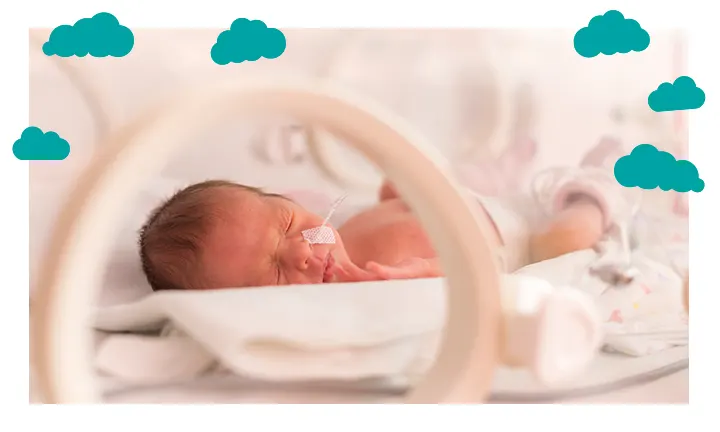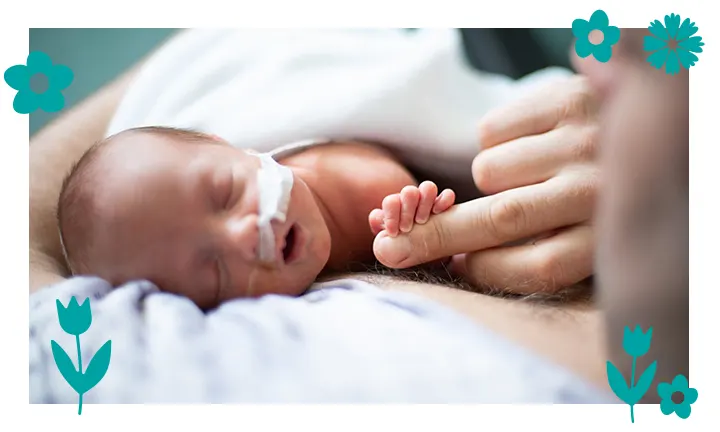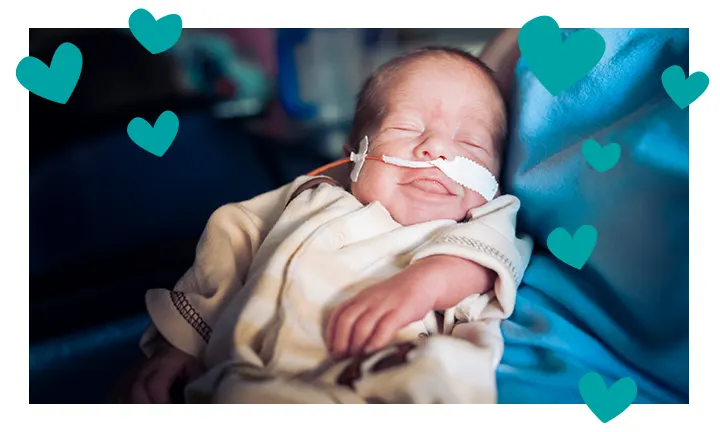20 Need to know Facts about Premature Babies!
Did you know Pampers created its smallest nappy specifically designed for premature babies way back in 2002 when a Pampers researcher was made aware of the fact that the nappies available for premature babies at the time were just not adequate. As part of an in-depth study spanning three continents, nurses told Pampers that the current nappies available did not fit the smallest babies and were often cut and folded to size. Pampers developed our Preemie Protection nappies to offer a more customised fit and to protect their delicate skin. The nappies are available in three sizes – P1 (1.8kg), P2 (1.1kg) and P3 (0.5kg), which is three times smaller than a regular nappy for a newborn baby, and all offer a customised fit which can be adapted to fit around lifesaving lines and leads. They minimise disruption during sleep and change time and aid the healthy development of baby’s hips and legs, whilst protecting their delicate skin. In order to honour these tiny fighters we’d like to share 20 fab facts about prematurity and Pampers’ support for premature babies today, tomorrow & every day. 1. Did you know that 1 in 13 babiesᶦ in the UK is born prematurely? That’s around 60,000 babies every year 2. So what does prematurity mean? It simply means a baby is born early, but did you know that there are three broad categories of prematurity based on the week a baby was born?
Moderate to late preterm: Baby born at 32-37 weeks
Very preterm: Baby born at 28-32 weeks
Extremely preterm: Baby born before 28 weeks
3. Premature baby’s skin is up to 2 times thinner than a full-term baby’sᶦᶦ, it’s incredibly sensitive to the world around, so every little touch matters. That means everything that touches them needs to be kind to their delicate skin and offer gentle protection. Pampers preemie nappies use extra gentle materials for their delicate skin to make sure premature babies experience a light touch. 4. The outer layer of that delicate preterm skin isn’t visible before 34 weeksᶦᶦᶦ. As a result, premature babies’ skin looks translucentᶦᵛ and sometimes appears to be red; and it loses this transparency as it matures.
5. Did you know touch is the first sense baby develops in the womb?ᵛ Touch releases oxytocin (the love & bonding hormone) and mediates the way a baby respond to stressᵛᶦᶦ. Preterm babies often have to undergo necessary medical procedures, touch is therefore more important than ever. 6. One of the ways for parents to support newborn development, especially preterm babies, is kangaroo care, a form of skin-to-skin touch, where the parent holds a baby on their chest. Benefits for babies born prematurely include heartbeat and breathing stability, improved and more sleep, decrease in crying, and pain management for babies, as well as weight gain. ᵛᶦᶦᶦ,ᶦˣ,ˣ,ˣᶦ 7. The brain is the last major organ to develop during the pregnancy and continues to mature even after the baby is bornˣᶦᶦ. Babies who are born full-term are fully equipped to continue this development outside the womb, but preterm babies need extra time to continue the important process that typically happens in late pregnancy. 8. That also makes sleep so critical for preterm babies! They sleep 90% of the time and engage in longer, lighter and more active sleep than full-term babiesˣᶦᶦ allowing them to keep maturing physically and neurologicallyˣᶦᵛ outside the womb.
9. With an early delivery a preterm baby is forced to leave the protected environment of the womb to enter a neonatal intensive care unit (NICU) in a hospital. Understandably, this can be a stark shift in the baby’s sensory environment with an increase in exposure to touch and handling, movement, smell, sound, light and sleep disruption.ˣᵛ,ˣᵛᶦ While the NICU is the best place for a preterm baby after birth, being in a hospital intensive care unit means there are several unavoidable factors which can disturb a preemie’s precious sleep. 10. Essential care in the NICU can mean that a baby born prematurely will experience up to 200 handling episodes in 24 hours.ˣᵛᶦᶦ The NICU staff works hard to minimise all of this as part of the baby’s care, prioritising sleep, proper developmental positioning and a nurturing, non-disruptive environment. 11. Preterm babies can have their nappy changed 6–8 times a day in the NICU. Each change can be stressful and disruptive to the preterm babyˣᵛᶦᶦᶦ and can impact the quality sleep a preterm baby needs for healthy physical and emotional development. Pampers’ Preemie Protection nappies can lengthen the time between changes needed, from three hours up to six. This helps allows them to have more uninterrupted sleep and therefore supports the healthy physical and emotional development they need. 12. Pampers was the first major brand to create their smallest nappy especially for premature babies back in 2002. But how did it come about? The story began with US-based Pampers researcher, Susan Ludwig in 1996. Susan witnessed first-hand the limitations of existing nappies on premature babies when she shared a ward post-birth with the mother of a preemie. A maternity nurse explained to Susan how existing nappies had a huge impact on a preemie’s early life – they didn‘t fit, leaked and woke up the babies unnecessarily. Susan knew she had the power to make a change.
13. When Pampers launched its smallest nappy to date in 2016, it had partnered with 150 NICU nurses in 7 countries to better understand unique needs of babies born prematurely. The nappy was designed to fit babies weighing only 400-900g: that’s approximately three times smaller than a nappy for a full-term born baby. 14. In 2019, when Pampers launched an improved preemie nappy design, they collaborated with 200 nurses and conducted more than 215 hours of research interviews. 15. Today, Pampers put everything into creating their smallest nappy for babies that need the most care: 10,000 hours of research, and collaboration and surveys with over 900+ nurses (not forgetting 20 years of wider Pampers research & innovation). 16. Pampers has been in hospitals around the world for more than 40 years. This puts Pampers in a unique position to understand preemie care from the frontline and build on conversations with nurses, year on year. 17. In 2017 Pampers launched the #PampersforPreemies campaign to support premature babies. Since 2018 the #PampersforPreemies campaign has led to more than 1 million preemie nappy donations to hospitals nationwide as part of Pampers pledge to help preemies get the best possible start in life.
18. Friends and families of babies born prematurely can now order their Pampers Preemie Protection Nappies online for free home delivery via www.pampers.co.uk/preemies-ordering-platform. Pampers also continue to donate Pampers Preemie Protection nappies direct to hospitals, and via ASDA pharmacies (in-store only and subject to availability) 19. Pampers has been lucky to work with some incredible partners, for example leading baby charity Bliss and in-hospital technology partner vCreate to help parents stay connected to their babies despite COVID-19 restrictions by supporting video technology in NICUs. 20. Pampers will continue supporting parents, caregivers and neonatal nurses not just in the UK, but also worldwide, in order to help give preterm babies everywhere the best possible start. With our 2030 ambition, we will help to;
Educate 100 million parents about prematurity.
Support 100,000 more neonatal experts in sharing best practices in Preemie care.
Donate 100 million specially-designed Preemie diapers or the equivalent product value to hospitals or Preemie associations across a number of countries
Pampers is committed to help make the world a better place for every baby, because giving babies a safe, happy and healthy start in life is what’s driven us for more than 50 years. Through programs launching in 2023 and beyond, together with parents and our partners, we will show big love to every baby born today, tomorrow…and every day.
ᶦᶦ Visscher M, Narendran V. The Ontogeny of Skin. Adv Wound Care (New Rochelle). 2014 Apr 1;3(4):291-303.
ᶦᶦᶦ G. N. Stamatas*, J. Nikolovski, M. C. Mack and N. Kollias (2011). Infant skin physiology and development during the first years of life: a review of recent findings based on in vivo studies. International Journal of Cosmetic Science, 33, 17–24.
ᶦᵛ Hoeger PH, Enzmann CC. Skin physiology of the neonate and young infant: a prospective study of functional skin parameters during early infancy. Pediatr. Dermatol. 2002;19:256-62
ᵛ Marcus L, Lejeune F, Berne-Audéoud F, Gentaz E, Debillon T. Tactile sensory capacity of the preterm infant: manual perception of shape from 28 gestational weeks. Pediatrics. 2012 Jul;130(1):e88-94. doi: 10.1542/peds.2011-3357
ᵛᶦ Fairhurst, Merle; Loken, Line; and Grossmann, Tobias. “ Physiological and behavioral responses reveal 9-month-old infants’ sensitivity to pleasant touch.” Psychological Science. (2014): DOI 10.1177/0956797614527114
ᵛᶦᶦ Feldman R. et al. Touch attenuates infants' physiological reactivity to stress. Dev Sci. 2010 Mar;13(2):271-8.
ᵛᶦᶦᶦ Jones, L., Laudiano-Dray, M. P., Whitehead, K., Meek, J., Fitzgerald, M., Fabrizi, L., & Pillai Riddell, R. (2021). The impact of parental contact upon cortical noxious-related activity in human neonates. European Journal of Pain (United Kingdom), 25(1).
ᶦˣ Bastani F et al. The Effects of Kangaroo Care on the Sleep and Wake States of Preterm Infants. J Nurs Res. 2017 Jun;25(3):231-239.
ˣ Kostandy RR, Ludington-Hoe SM, Cong X, Abouelfettoh A, Bronson C, Stankus A, Jarrell JR. Kangaroo Care (skin contact) reduces crying response to pain in preterm neonates: pilot results. Pain Manag Nurs. 2008 Jun;9(2):55-65
ˣᶦ Evereklian M. et al. The Impact of Kangaroo Care on Premature Infant Weight Gain. J Pediat. Nurs. 2017. 34(10-16)
ˣᶦᶦ D’Agata Amy L, et al. Novel method of measuring chronic stress for preterm infants: Skin cortisol, Psychoneuroendocrinology, (2019) 102, 204–211
ˣᶦᶦᶦ Barbeau DY, Weiss MD. Sleep Disturbances in Newborns. Children (Basel). 2017;4(10):90. Published 2017 Oct 20. doi:10.3390/children4100090
ˣᶦᵛ Cao J et al. Unravelling why we sleep: Quantitative analysis reveals abrupt transition from neural reorganization to repair in early development. Neuroscience. 2020; 6(38)
ˣᵛ Jinhee Park. Sleep promotion for Preterm infants in the NICU. 2020. 24: 24-35
ˣᵛᶦ Graven SN, Bowen FW Jr, Brooten D, Eaton A, Graven MN, Hack M, Hall LA, Hansen N, Hurt H, Kavalhuna R, et al. The high-risk infant environment. Part 1. The role of the neonatal intensive care unit in the outcome of high-risk infants. J Perinatol. 1992 Jun;12(2):164-72.
ˣᵛᶦᶦ Murdoch DR and Darlow BA (1984). Handling during neonatal intensive care, Archives of Disease in Childhood, 59, 957-961
ˣᵛᶦᶦᶦ Morelius E et al. Is a nappy change stressful for neonates? Early Human Development. 2006; 10: 669-79
Read more about Prematurity
Join Pampers Club and get:






